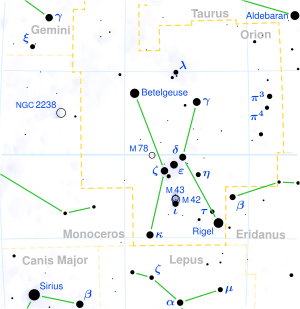Mu Orionis

| |
| Observation data Epoch J2000 Equinox J2000 | |
|---|---|
| Constellation | Orion |
| A | |
| Right ascension | 06h 02m 22.997s[1] |
| Declination | +09° 38′ 50.24″[1] |
| Apparent magnitude (V) | 4.30[2] |
| B | |
| Right ascension | 06h 02m 23.009s[1] |
| Declination | +09° 38′ 50.52″[1] |
| Apparent magnitude (V) | 6.27[2] |
| Characteristics | |
| A | |
| Spectral type | A1 Vm |
| U−B color index | +0.11[3] |
| B−V color index | +0.14[3] |
| B | |
| Spectral type | F2 V |
| U−B color index | +0.00[3] |
| B−V color index | +0.43[3] |
| Astrometry | |
| Radial velocity (Rv) | 0.00[4] km/s |
| Proper motion (μ) | RA: 10.43[5] mas/yr Dec.: −39.09[5] mas/yr |
| Parallax (π) | 21.05 ± 0.68[5] mas |
| Absolute magnitude (MV) | Aa: 0.93 Ba: 3.53 Bb: 3.53[3] |
| Orbit[6] | |
| Primary | A |
| Companion | B |
| Period (P) | 6,813.8 ± 1.2 days |
| Semi-major axis (a) | 273.7 ± 2.1" (12.620 ± 0.057 AU) |
| Eccentricity (e) | 0.7410 ± 0.0011 |
| Inclination (i) | 96.028 ± 0.028° |
| Orbit[6] | |
| Primary | Aa |
| Companion | Ab |
| Period (P) | 4.4475849 days |
| Semi-major axis (a) | 1.661 ± 0.013" (0.07659 ± 0.00058 AU) |
| Eccentricity (e) | 0.0037 ± 0.0014 |
| Inclination (i) | 47.1 ± 9.0° |
| Semi-amplitude (K1) (primary) | 1.03 ± 0.26 km/s |
| Semi-amplitude (K2) (secondary) | > 4.58 km/s |
| Orbit[6] | |
| Primary | Ba |
| Companion | Bb |
| Period (P) | 4.7835349 days |
| Semi-major axis (a) | 1.688 ± 0.013" (0.07659 ± 0.00036 AU) |
| Eccentricity (e) | 0.0016 ± 0.0014 |
| Inclination (i) | 110.71 ± 0.73° |
| Semi-amplitude (K1) (primary) | 1.72 ± 0.26 km/s |
| Semi-amplitude (K2) (secondary) | 2.02 ± 0.26 km/s |
| Details[3][6] | |
| Aa | |
| Mass | 2.38 M☉ |
| Radius | 2.85 R☉ |
| Luminosity | 32.2 L☉ |
| Temperature | 8,300 K |
| Rotational velocity (v sin i) | 10[7] km/s |
| Ab | |
| Mass | 0.652 M☉ |
| Ba | |
| Mass | 1.389 M☉ |
| Radius | 1.33 R☉ |
| Luminosity | 3.0 L☉ |
| Temperature | 6,600 K |
| Bb | |
| Mass | 1.356 M☉ |
| Radius | 1.33 R☉ |
| Luminosity | 3.0 L☉ |
| Temperature | 6,600 K |
| Other designations | |
| Database references | |
| SIMBAD | μ Ori data |
| SIMBAD | μ Ori A data |
| SIMBAD | μ Ori B data |
Mu Orionis is a quadruple star system[6] in the constellation Orion, similar to Mizar and Epsilon Lyrae with combined visual magnitude of 4.13. The four stars are known as Mu Orionis Aa, Mu Orionis Ab, Mu Orionis Ba, and Mu Orionis Bb. All four components are spectroscopic, with A and B systems only several tenths of an arcsec apart. The entire system is located approximately 155 Light Years from the Sun.
Mu Orionis Aa is an A5V dwarf and metallic line star, of effective temperature 8350 Kelvin, and apparent magnitude of +4.31. Mu Orionis Aa has 2.1 solar masses, and a radius of 2.9 solar radii and a luminosity 32x that of the Sun.
Mu Orionis Ab is a G5V dwarf orbiting Aa at a distance of 0.077 AU, .2x the orbit of mercury.
Mu Orionis Ba and Bb are F5V dwarfs with 1.4 solar masses and apparent magnitudes of 6.91. They are separated from eacu other by 0.078 AU.
μ Orionis falls just outside an unrelated planetary nebula Abell 12. The bright star makes detecting the faint nebula difficult and it has been nicknamed The Hidden.
References
- 1 2 3 4 Fabricius, C.; Høg, E.; Makarov, V. V.; Mason, B. D.; Wycoff, G. L.; Urban, S. E. (2002). "The Tycho double star catalogue". Astronomy and Astrophysics. 384: 180. Bibcode:2002A&A...384..180F. doi:10.1051/0004-6361:20011822.
- 1 2 Mason, Brian D.; Wycoff, Gary L.; Hartkopf, William I.; Douglass, Geoffrey G.; Worley, Charles E. (2001). "The 2001 US Naval Observatory Double Star CD-ROM. I. The Washington Double Star Catalog". The Astronomical Journal. 122 (6): 3466. Bibcode:2001AJ....122.3466M. doi:10.1086/323920.
- 1 2 3 4 5 6 Fekel, Francis C.; Scarfe, C. D.; Barlow, D. J.; Hartkopf, William I.; Mason, Brian D.; McAlister, Harold A. (2002). "The Quadruple System μ Orionis: Three-dimensional Orbit and Physical Parameters". The Astronomical Journal. 123 (3): 1723. Bibcode:2002AJ....123.1723F. doi:10.1086/339184.
- ↑ Pourbaix, D.; Tokovinin, A. A.; Batten, A. H.; Fekel, F. C.; Hartkopf, W. I.; Levato, H.; Morrell, N. I.; Torres, G.; Udry, S. (2004). "SB9: The ninth catalogue of spectroscopic binary orbits". Astronomy and Astrophysics. 424 (2): 727. arXiv:astro-ph/0406573
 . Bibcode:2004A&A...424..727P. doi:10.1051/0004-6361:20041213.
. Bibcode:2004A&A...424..727P. doi:10.1051/0004-6361:20041213. - 1 2 3 Van Leeuwen, F. (2007). "Validation of the new Hipparcos reduction". Astronomy and Astrophysics. 474 (2): 653. arXiv:0708.1752
 . Bibcode:2007A&A...474..653V. doi:10.1051/0004-6361:20078357.
. Bibcode:2007A&A...474..653V. doi:10.1051/0004-6361:20078357. - 1 2 3 4 5 Muterspaugh, Matthew W.; et al. (2008). "Masses, Luminosities, and Orbital Coplanarities of the μ Orionis Quadruple-Star System from Phases Differential Astrometry". The Astronomical Journal. 135 (3): 766–776. arXiv:0710.2126
 . Bibcode:2008AJ....135..766M. doi:10.1088/0004-6256/135/3/766.
. Bibcode:2008AJ....135..766M. doi:10.1088/0004-6256/135/3/766. - ↑ Fekel, Francis C. (2003). "Rotational Velocities of B, A, and Early-F Narrow-lined Stars". The Publications of the Astronomical Society of the Pacific. 115 (809): 807. Bibcode:2003PASP..115..807F. doi:10.1086/376393.